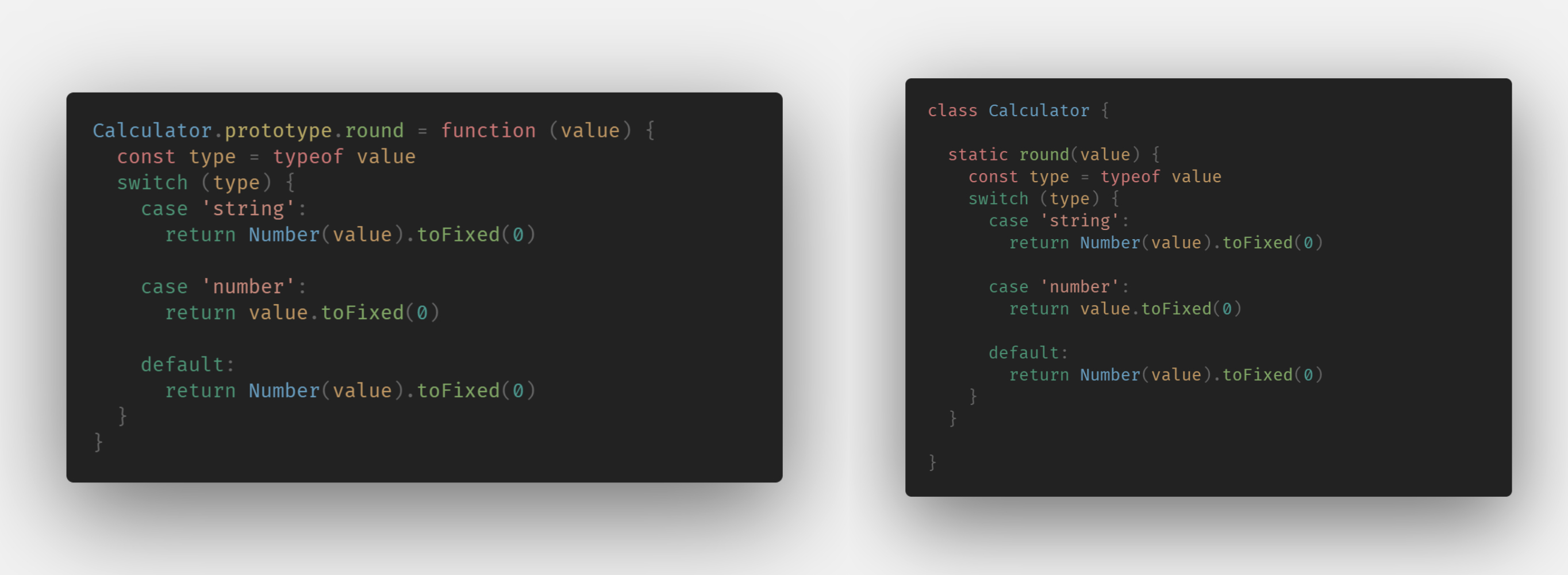描述
在面向对象编程中一个类定义了一个对象的特征. 类是定义 properties 和 一些方法, 是用来绘制具体对象实例的“蓝图”
在 ES6 中 class 本质上就是一个语法糖,使我们编写构造函数更为方便
特性
- 在使用
function写法时在prototype上定义方法是默认可枚举的,在使用calss写法时在prototype上定义方法是默认不可枚举的 class也存在暂时性死区的特性- 取值函数和存值函数依然可以使用
- 默认使用严格模式
- 默认会有一个
constructor不写不会报错 new方式来执行,不使用new执行则报错- 内部使用
this互相调用使用方法和属性
基本写法
class Calculator { // 此时声明了一个构造函数 Calculator}
声明变量和方法
class Calculator {// 声明了两个初始变量 num1 和 num2 初始值都为 undefinnum1num2// 声明了一个初始变量 action 初始值为 'plus'action = 'plus'// 声明方法 plusplus() {return this.a + this.b}// 声明方法 subsub() {return this.a - this.b}// 声明方法 mulmul() {return this.a * this.b}// 声明方法 divdiv() {return this.a / this.b}}
当然,也可以使用变量赋值来声明方法,箭头函数也是可以的
class Foo {fn = function () { }arrowFn = () => { }}
类的初始化 constructor
class Calculator {num1num2// 使用 constructor 来使得 class 被 new 时执行的程序constructor(num1, num2) {this.num1 = num1this.num2 = num2}}
静态方法和静态属性
使用 static 关键字来声明 类 内部的静态方法和属性
静态方法和静态属性无法被 实例化对象 调用
class Calculator {// 声明了一个静态属性 actions 初始值为 ['plus', 'sub', 'mul', 'div']static actions = ['plus', 'sub', 'mul', 'div']// 声明了一个静态方法 roundstatic round(value) {const type = typeof valueswitch (type) {case 'string':return Number(value).toFixed(0)case 'number':return value.toFixed(0)default:return Number(value).toFixed(0)}}}
使用 class
class Calculator {// 声明了两个初始变量 num1 和 num2 初始值都为 undefinnum1num2// 声明了一个初始变量 action 初始值为 'plus'action = 'plus'// 声明了一个静态属性 actions 初始值为 ['plus', 'sub', 'mul', 'div']static actions = ['plus', 'sub', 'mul', 'div']// 声明了一个静态方法 roundstatic round(value) {const type = typeof valueswitch (type) {case 'string':return Number(value).toFixed(0)case 'number':return value.toFixed(0)default:return Number(value).toFixed(0)}}// 使用 constructor 来使得 class 被 new 时执行的程序constructor(num1, num2) {this.num1 = num1this.num2 = num2}// 声明方法 plusplus() { return this.num1 + this.num2 }// 声明方法 subsub() { return this.num1 - this.num2 }// 声明方法 mulmul() { return this.num1 * this.num2 }// 声明方法 divdiv() { return this.num1 / this.num2 }run() {switch (this.action) {case 'plus':return this.plus()case 'sub':return this.sub();case 'mul':return this.mul()case 'div':return this.div()default:return this.plus()}}}// 使用 new 关键字来实例化 类(构造函数)const calculator = new Calculator(5, 10,)// 调用实例化对象的 run 方法console.log(calculator.run()) // 15// 更改实例化对象的 action 属性calculator.action = 'mul'// 调用实例化对象的 run 方法console.log(calculator.run()) // 50// 更改实例化对象的 action 属性calculator.action = 'div'// 调用实例化对象的 div 方法console.log(calculator.div()) // 0.5// 调用 类(构造函数) 上的 静态方法 roundconsole.log(Calculator.round('10.99')) // 11// 访问 类(构造函数) 上的 静态属性 actionsconsole.log(Calculator.actions) // ['plus', 'sub', 'mul', 'div']
属性的私有化
用在一些属性成员不想被外部访问的情况
const drink = Symbol()function study() {console.log('I am studing');}class Person {// 相对私有化[drinkAction]() {console.log('I can drink');}// 绝对私有化study() {study.call(this)}}
访问和赋值的 get 和 set
在 类 中依然可以使用 get 和 set
class Person {_age = 0get age() {return this._age++}set age(value) {if (value > 100) {console.log("年龄最大不得大于100岁")return false}if (value < 0) {console.log("年龄最小不得小于0岁")return}this._age = value}}var person = new Person()console.log(person.age) // 0console.log(person.age) // 1person.age = 101 // 年龄最大不得大于100岁console.log(person.age) // 2person.age = -1 // 年龄最小不得小于0岁console.log(person.age) // 3person.age = 55console.log(person.age) // 55
extends
extends 是 class 继承的关键字
继承方式相对 function 来讲则要简单的许多,只需要使用 extends 关键即可
class Father {work() {console.log('I am working')}}class Son extends Father {study() {console.log('I am studing')}}var son = new Son()son.study() // I am workingson.work() // I am studing
关键字 super
如果在 子类中 使用了 constructor,则必须之中 super 函数,否则会报错
class Parent {constructor(name = "parent") {this.name = name}}class Child extends Parent {// 如果写了 constructor 一定要写 super()constructor() {super() // super 不写则报错u}
new
在使用 class 时,必须通过 new 实例的方式去执行构造函数 否则会报错
const obj = {}class Foo {constructor(name) {this.name = name}}// 以下几个执行均报错// Class constructor Foo cannot be invoked without 'new'Foo('nothing')Foo.call(obj)Foo.apply(obj)
function vs Class
声明
属性的定义
静态属性的定义
方法的定义
静态方法的定义






